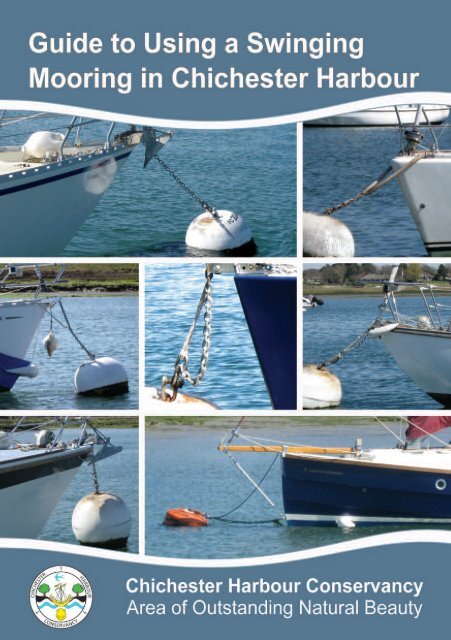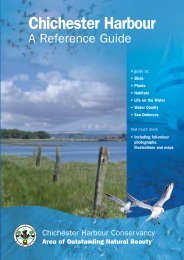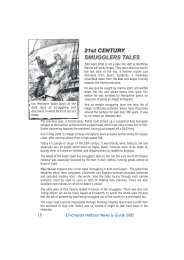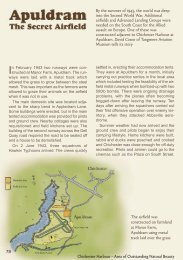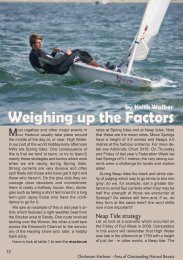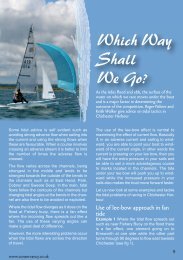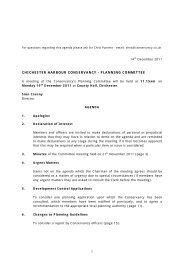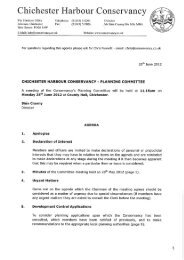Guide to Using a Swinging Mooring - Chichester Harbour ...
Guide to Using a Swinging Mooring - Chichester Harbour ...
Guide to Using a Swinging Mooring - Chichester Harbour ...
Create successful ePaper yourself
Turn your PDF publications into a flip-book with our unique Google optimized e-Paper software.
<strong>Mooring</strong>EquipmentA Conservancy maintainedmooring consists of a heavyblack iron chain riser, whichis attached <strong>to</strong> a sinker orground chain. The swivelallows the boat <strong>to</strong> swingfreely at the mooring withouttwisting or snagging themooring <strong>to</strong>p chain and anyropes passed <strong>to</strong> the swivel.The length of the <strong>to</strong>p chain is standardised <strong>to</strong> suit the average deck layout of atypical yacht using our moorings and is approximately 2.5m long. The length of<strong>to</strong>p chain will not suit all deck arrangements and it may need <strong>to</strong> be adjusted <strong>to</strong>suit your individual requirement. It can be shortened by increasing the size of theend loop; or on rare occasions, lengthened by introducing an additional length <strong>to</strong>the chain.
Considerations When Securing <strong>to</strong> a BuoyMoored boats behave in different ways; characteristics suchas hull shape and draft will affect how a boat lies at themooring during changes in the tide. Windage on sprayhoods and canvas covers, will be affected by thestrength of the wind and wind direction, which alsoplays a part in creating a unique swinging patternand how the vessel lies with neighbouring boats.Minimising the swinging circle is an importantconsideration. The length of the mooring <strong>to</strong>p chainbetween the deck fairlead and the buoy should be asshort as possible. This also ensures that the weight of theboat is directly linked <strong>to</strong> the riser and limits the amount ofsnatch <strong>to</strong> the boat deck fittings.An excessively long <strong>to</strong>p chain will alsocause the buoy <strong>to</strong> rub alongside thehull of the boat and scuff the gel coa<strong>to</strong>r varnish. This is often observed andcan be reduced by using the correctlength of <strong>to</strong>p chain as previouslydescribed.<strong>Mooring</strong> SwivelIt is important that the swivel on the <strong>to</strong>pof the buoy is free <strong>to</strong> rotate and that nothing is attached from the boat below thisswivel, such as a rope preventer.A rope secured directly <strong>to</strong> the buoy will quicklyfoul the swivel and cause the <strong>to</strong>p chain <strong>to</strong> twistand shorten, which then hampers the freeswinging of the boat at the mooring.Any boat using a mooring must haveinsurance against third-party claims for atleast the minimum sum recommended byleading marine insurers.
Deck ArrangementsThere are many variations of deck layouts and eachwill have its own considerations when securing <strong>to</strong> aswinging mooring. The most effective arrangementis one with a bow fairlead; this enables a straightpull <strong>to</strong> a deck fairlead or Samson post. The mooring<strong>to</strong>p chain should lie on the roller with a drop nosepin or lashing above the chain <strong>to</strong> prevent the chainfrom jumping out of the fairlead. It is important thatthe pin does not interfere with the movement of thechain or take any weight.Where the <strong>to</strong>p chain is fed through a fairleadmounted on the port or starboard side of the boat,the fairleads should be large enough <strong>to</strong> permit thechain <strong>to</strong> move through the fairlead and not <strong>to</strong> take the weight of the mooringdirectly.Alternatively a rope bridle attached <strong>to</strong> the mooring buoy, above the mooringswivel, could be used; the rope bridle can be adjusted so that the rope wouldtake the weight of the boat in normal conditions. It is important that the galvanised<strong>to</strong>p chain is fitted <strong>to</strong> the boat in some manner, so that if the rope bridlefails the boat remains safely moored.Small boats that are not fitted with suitable deck arrangements <strong>to</strong> secure thebuoy <strong>to</strong>p chain can secure the chain <strong>to</strong> the bow ‘D’ ring (the steel ring on thebow of the boat that isused <strong>to</strong> pull the boat on<strong>to</strong> a trailer); a stainlesssteel snap shackle fitted<strong>to</strong> the <strong>to</strong>p chain isthe simplest way ofachieving this. A ropebridle can then be fittedfrom the boat <strong>to</strong> adjustand manage the safemooring of the boat <strong>to</strong>the buoy.
PreventersSome boat owners prefer <strong>to</strong> fit a ropebridle, in addition <strong>to</strong> the <strong>to</strong>p chain;this can help <strong>to</strong> minimise the weareffect that the <strong>to</strong>p chain mayhave on rollers and fairleads. Aplastic tube fitted where the linepasses through thefairlead/roller, can also reducechaff. The fitting of spring or rubbersnubbers favoured by someboat owners is also an option.DroguesFor light displacement boats or boats with a highfree board, which have a tendency <strong>to</strong> ride with the wind rather than the tide, it isrecommended that a drogue be fitted at the stern of the boat. This can be aplastic bucket or canvas bag on a short length of line and will have the effect ofslowing down the rate of swing.Private <strong>Mooring</strong>sAll moorings are categorised by the maximum length of vessel authorised by themooring site licence issued by the Conservancy. Whilst a mooring may be classifiedas a C3, for instance a half tide mooring for a vessel up <strong>to</strong> 9m, this is subject<strong>to</strong> local conditions and spacing with adjacent moorings. It should be borne inmind how a boat will sit when drying and re-floating on the change of tide.NB: Details in the Conditions of Site Licence or Hire of a mooring should be readcarefully by any boat owner using a mooring with regard his own liability.The most common cause of a boat breaking awayfrom a mooring is the failure of rope bridles; theseshould be thoroughly checked at regular intervals.Deck fittings, which are subjected <strong>to</strong> high forces,should also be checked regularly.
Provisions for RoughWeatherIf the advice in this leaflet is followed a yachtwill be well prepared for rough weather.However, there are a number of additionalprecautions that should be considered;yachtsmen should be aware of the windloading effect caused by spray hoods,loose/flapping sails and the potential fordamage <strong>to</strong> equipment not securely fastened.Ideally sails, sail covers and any loose deckequipment should be removed from the boatduring the autumn and winter months. If youdo leave sails on under a sail cover, this should be securely lashed with all looseends tied. Furling headsails should be tightly s<strong>to</strong>wed with the sheets wrappedaround the sail at least once and any loose ropes tied down.Boats with lifting keels on a deepwater mooring should keep their keels down.This is particularly important for light displacement yachts, which could beknocked down in strong winds.Tori ChittyShould you have any further queries about the bestway <strong>to</strong> safely moor your boat, please contact the<strong>Mooring</strong>s Officer at the <strong>Harbour</strong> Office - 01243 510980<strong>Chichester</strong> <strong>Harbour</strong> Conservancy<strong>Harbour</strong> OfficeItchenor<strong>Chichester</strong> PO20 7AW01243 512301harbourmaster@conservancy.co.ukwww.conservancy.co.ukAll pho<strong>to</strong>s: <strong>Chichester</strong> <strong>Harbour</strong> Conservancy. If you are unable <strong>to</strong> use thisleaflet, please pass it on <strong>to</strong> someone who would be interested or recycle it.Published by <strong>Chichester</strong> <strong>Harbour</strong> Conservancy 2011


